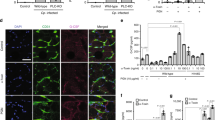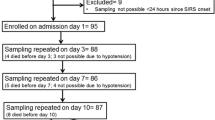Abstract
Tumor necrosis factor (TNF) has a pivotal role in the pathogenesis of sepsis and septic shock. Suppression of its biosynthesis might therefore be one of the strategies in the treatment of sepsis. When peripheral white blood cells were stimulated with eitherE. coli lipopolysaccharide (LPS) orStaphylococcus aureus, pentoxifiline (PTX) inhibited TNF production. In contrast, only a moderate inhibitory effect was observed on the induction of interleukin 6 (IL-6). PTX inhibited not only the TNF production of monocytes, but also the TNF and IL-6 producing capacities were higher in septic patients (n=31) than in healthy blood donors (n=15). Administration of PTX (400 mg/day) to 20 of the septic patients resulted in TNF production similar to that found in healthy controls. It also subsequently led to an improvement of the clinical status classified by the APACHE II score. The soluble intercellula adhesion molecule-1 (sICAM-1) level was significantly higher in the sera of septic patients before PTX treatment (800–1200 ng/ml) than in normal individuals (50–150 ng/ml), but it decreased following PTX therapy. Cytofluorometric analysis revealed that the expression of ICAM-1 on stimulated mononuclear cells was inhibited by PTX. It is presumed that the suppressive effect of pentoxifylline on TNF production may be of clinical importance, improving the therapeutic strategies in septic syndrome.
Similar content being viewed by others
References
Billiau A, Vandekerchove F (1991) Cytokines and their interactions with other inflammatory mediators in the pathogenesis of sepsis and septic shock. Eur J Clin Invest 21: 559–573
Tracey KJ (1991) Tumor necrosis factor (cachectin) in the biology of septic shock syndrome. Circ Shock 35: 123–128
Doherty GM, Jensen JC, Alexander HR, Buersh CM, Norton JA (1991) Pentoxifylline suppression of tumor necrosis factor gene transcription. Surgery 110: 192–198
Schönharting MM, Schade UF (1989) The effect of pentoxifylline in septic shock: new pharmacologic aspects of an established drug. J Med 20: 97–105
Zabel P, Schade FU, Schlaak M (1993) Inhibition of endogenous TNF formation by pentoxifylline. Immunobiology 187: 447–463
Gearing AJ, Hemingway I, Pigott R, Hughes J, Rees AJ, Cashman SJ (1992) Soluble forms of vascular adhesion molecules, E-selectin, ICAM-1, and VCAM-1: pathological significance. Ann NY Acad Sci 667: 324–331
Knaus W, Draper E, Wagner DP, Zimmerman JE (1985) APACHE II: a severity of disease classification. Crit Care Med 13: 818–829
Espevik T, Niessen-Meyer JA (1986) A highly sensitive cell line WEHI 164 for measuring cytotoxic factor/tumor necrosis factor. J Immunol Methods 95: 99–105
Aarden LA, deGroot ER, Shaap OL, Lansdorp PM (1987) Production of hybridoma growth factor by human monocytes. Eur J Immunol 17: 1411–1416
Mándi Y, Endrész V, Krenács L, Régely K, Degré M, Béládi I (1991) Tumor necrosis factor production by human granulocytes. Int. Arch Allergy Appl Immunol 96: 102–105
Meldrum DR, Ayala A, Chaudry IHJ (1994) Energetics lymphocyte burnout in late sepsis. Adjuvant treatment with ATP MgCl2 improves energetics and decrease lethality. Surg Res 56: 537–542
Zabel P, Wolter DT, Schönharting MM, Schade UF (1989) Oxypentifylline in endotoxaemia. Lancet 334: 1474–1477
Waage A, Sorensen M, Stordal B (1990) Differential effect of oxypentoxifylline on tumour necrosis factor and interleukin-6 production. Lancet 335: 543
Bienvenu J, Coulon L, Barbier Y, Barbier M, Doche C, Lepape A, Guenounou M (1992) Study of pentoxifylline induced modulation of TNF alpha and interleukin-6 secretion in healthy and septic patients by the use of an ex-vivo model on whole blood. Nouv Rev Fr Haematol 34 (Suppl): S 65–67
Gearing AJ, Newman W (1993) Circulating adhesion molecules in disease. Immunol Today 14: 506–512
Küster H, Degitz K (1993) Circulating ICAM-1 in neonatal sepsis. Lancet 341: 506
Rothlein R, Mainolfi EA, Czajkowski M, Marlin SD (1991) A form of circulating ICAM-1 in human serum. J Immunol 147: 3788–3793
Hammerschmidt DE, Kotasek D, McCarthy T, Huh P-W, Freyburger G, Vercelotti GM (1988) Pentoxifylline inhibits granulocyte and platelet function, including granulocyte-priming by platelet activating factor. J Lab Clin Med 11: 254–261
Leenen D van, Poll T van der, Levi M, ten-Cate H, Deventer SJ van, Hack CE, Aarden L, ten-Cate JW (1993) Pentoxifylline attenuates neutrophil activation in experimental endotoxaemia in chimpanzees. J Immunol 151: 2318–2325
Zheng H, Crowley J, Chan JC, Hoffmann H, Hatheril A, Ishizaka A, Raffin TA (1990) Attenuation of tumor necrosis factor-induced endothelial cell cytotoxicity and chemiluminescence. Am Rev Respir Dis 142: 1073–1078
Mandell G, Sullivan GW (1991) Pentoxifylline: an inhibitor of inflammatory cytokine. In: Mandell GL, Novick WJ (eds) Pentoxifylline, leukocytes and cytokines. Proceedings of the workshop held at Scottsdale, Ariz., USA, March 8–10, pp 1–6
Author information
Authors and Affiliations
Rights and permissions
About this article
Cite this article
Mándi, Y., Farkas, G., Ocsovszky, I. et al. Inhibition of tumor necrosis factor production and ICAM-1 expression by pentoxifylline: beneficial effects in sepsis syndrome. Res. Exp. Med. 195, 297–307 (1995). https://doi.org/10.1007/BF02576800
Received:
Accepted:
Issue Date:
DOI: https://doi.org/10.1007/BF02576800




